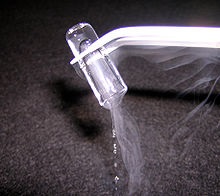|
|
| |
|
|
| |
|
|
|
|
| |
 |
| A small piece of
rapidly melting argon ice shows the transition
from solid to liquid. |
Phase
A phase change is a change in the states of matter. For
example, a solid may become a liquid. This phase change
is called melting. When a solid changes into a gas, it
is called sublimation. When a gas changes into a liquid,
it is called condensation. When a liquid changes into a
solid, it is called solidification. When a gas changes
into a solid, it is called deposition . When a liquid
changes into gas, it is called evaporation. Phase
changes are usually caused by changes in temperature or
pressure. |
|
|
As the states of matter change from solid to liquid to
gas, respectively, their composition changes as well.
For example, in a solid, the bonds are stronger than
hydrogen bonds. That allows the solid substance to have
a definite volume and shape. However, when the heat is
added to the solid and it melts to become a liquid, the
bonds are considerably weaker, and in water, are simply
hydrogen bonds. A liquid has a definite volume but not a
definite shape, and it thus takes the shape of the
container in which it is. When more heat is added, the
liquid substance evaporates and becomes a gas, which has
no bonds at all. Gas is simply a formless collection of
particles that tends to expand in all directions at the
same time in order to occupy its full container. If a
gas is not confined, the space between the particles
will continue to increase. A gas has neither a definite
volume nor a definite shape. |
|
|
In this pattern, solid to liquid to gas, heat is being
added in order to provoke the phase change. In the other
"direction," gas to liquid to solid, heat is being
released through the phase change. |
|
|
It often helps to think of an ice cube when thinking of
phase changes. An ice cube is a solid, and when heated
up, it becomes liquid water. When heated up some more,
it becomes water vapor, which is a gas. |
|
 Kiddle: Phase Kiddle: Phase
Wikipedia: Phase |
|
|
|
|
|
|
|
|
|
|
|
|
|
|
|
|
Search Fun Easy English |
|
|
|
|
|
|
|
|
|
|
|
|
|
|
|
About
Contact
Copyright
Resources
Site Map |